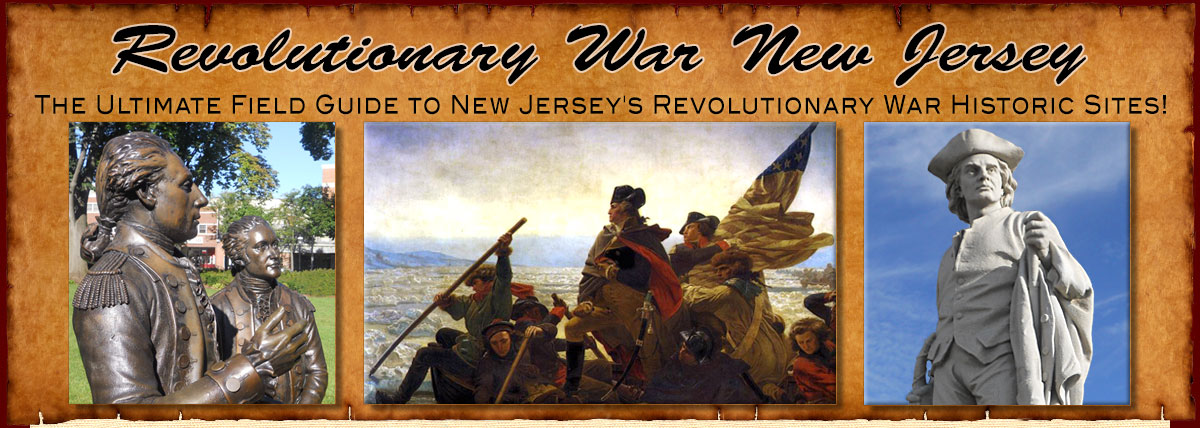

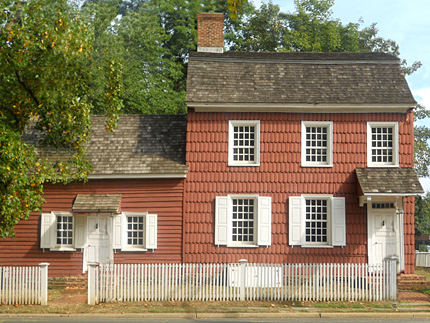
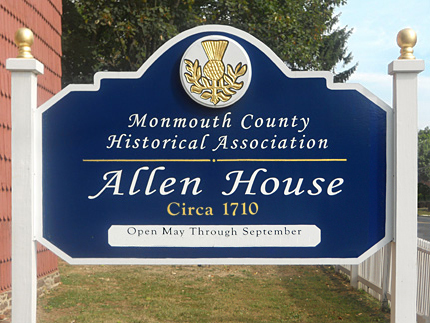
Allen House
400 Sycamore Ave.
Map / Directions to the Allen House
For more information about visiting the Allen House, see the Monmouth County Historical Association website
The Allen House
Operated as a Tavern during the Revolutionary War
This house is known as the Allen House because its original owner was named Judah Allen. Coincidently, in the early 1800's it was owned by another man named Allen who was most likely unrelated: Dr. Edmund Allen who used the house for his medical practice.
From the mid-1700's to the early 1800's, the house was used as a tavern, operated at times by different people. Taverns at the time served multiple purposes. In addition to serving alcohol and food, they offered lodging to travelers. They also served as places for a wide range of public functions, including town meetings, legal courts, and elections.
At the beginning of the Revolutionary War, the tavern was operated by Josiah Halstead, and his tavern served the same range of purposes for the community of Shrewsbury. [1]
An Important Shrewsbury Town Meeting Occurred at the Tavern Just Before the Start of the Revolutionary War,
Concerning a "Committee of Observation"
In 1774, tensions were increasing between the thirteen American colonies and the mother country Great Britain, which would soon lead to the Revolutionary War. The First Continental Congress convened in September, with delegates representing all thirteen British Colonies in America. By late October, the Continental Congress had agreed on a series of guidelines to address the current situation. One part of the guidelines stated that every town throughout the colonies should form a committee of observation, whose purpose would be to observe the local residents to make sure that they honor the other rules set forth in the document. [2]
Meetings were held in towns in New Jersey, as they were in towns throughout all thirteen colonies, to form Committees of Observation. One such meeting was held by the residents of Shrewsbury here in Josiah Halstead's tavern on January 17, 1775. The meeting was announced by posting the following notice for local residents to read: [3]
Agreeable to the Resolutions of the Late General Continental Congress—The Inhabitants of the town of Shrewsbury, more Especially Such as are properly Qualified for Choosing Representatives to Serve in General Assembly, are hereby Warned to meet at the House of Josiah Halstead, in said Shrewsbury, on Tuesday the 17th of this Instant, January, at noon, in Order to Choose a Committee for the Several purposes as Directed By the Said Congress.
Between thirty and forty local residents attended the meeting, but instead of forming a committee of observation, they voted not to have one. Their reasoning was described in a letter written by one of the attendees the following day: [4]
Between thirty and forty of the most respectable freeholders accordingly met and after a few debates on the business of the day, which were carried on with great decency and moderation, it was generally agreed (there being only four or five dissenting voices) that the appointment of a committee was not only useless, but they were apprehensive would prove a means of disturbing the peace and quietness which had hitherto existed in the township, and would continue to use their utmost endeavours to preserve and to guard against running upon that rock, on which, with much concern, they behold others, through an inattentive rashness, daily splitting.
Shrewsbury's decision not to create a Committee of Observation was met with disapproval by others in Monmouth County. A letter was sent from the County seat in Freehold to the citizens of Shrewsbury, asking them to reconsider. [5] On May 27, another meeting was held in a different tavern which did create a committee of observation for Shrewsbury. [6] By that time, the political disagreements between the colonies and Britain had turned into a shooting war. The previous month, the first battle of the Revolutionary War had occurred at Lexington and Concord in Massachusetts on April 19.
The Allen House Massacre
Summer 1779
In 1779, four years into the Revolutionary War, the Allen House was still a tavern, but it was no longer operated by Josiah Halstead. [7] During the summer of that year, the tavern was the site of a Tory attack which has become known as the "Allen House Massacre."
Tories (also referred to as Loyalists or refugees) were Americans who remained loyal to the British in the Revolutionary War. Violence between Loyalists and those who supported Independence happened throughout many parts of New Jersey, but Monmouth County was a particular hotspot for this type of fighting. Raiding parties of Loyalists (also called Tories) attacked Monmouth County many times.
The one known recorded account of the Allen House Massacre was written many years later in a letter by a Shrewsbury resident named Lyttleton White, who claimed to have heard the story on several occasions from Joseph Price, one of the Tories involved in the raid.
Lyttleton White's description of the event appears below. Note that the Episcopal Church he refers to is Christ Church, which is described in the entry lower on this page, and that a rod is equal to 16.5 feet, so six rods is 99 feet.
In the summer of 1779 - there was a Lieutenant stationed at Shrewsbury with a guard of 12 men to watch the movements of the Tories so called - and quartered in the house where Doctor Edmund W. Allen now lives - five of the Tories or Refugees came in a boat up a branch of South Shrewsbury River - landed and under cover of woods hedges and etc. - got the south side of the Episcopal Church about 6 rods from the above said house - the party being headed by Joseph Price and Richard Lippincott - they held a parlay + by looking from the corner of said church they found no sentries set and [the American soldiers] lounging about, not under arms - Price then ordered his party to fix their bayonets and started on full run for the house, where the troops was quartered - their arms all stood together in the North room - one of Price's men grabbed them all in his arms - A scuffle took place being 12 [American soldiers] to 5 of the Refugees - the man who held fast on the guns of the American troops was thrown but held fast - they put the bayonet through one of the 12 and he fell at once on the floor - and run two more of the them through, the Lieutenant then surrendered -- one of the two last killed got out into the road, his bowels coming out, he soon died; the other one got somewhat farther off and fell and likewise died - - [The Tories] took the other 9 prisoners - broke their guns round a Locust tree, and made their escape. [8]

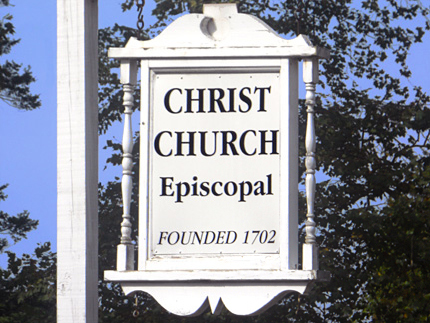
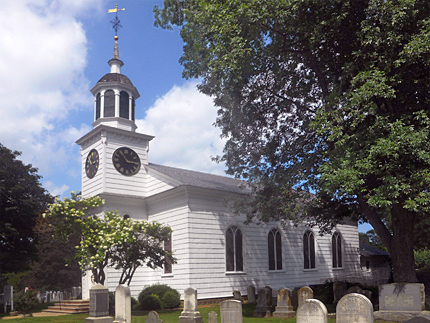
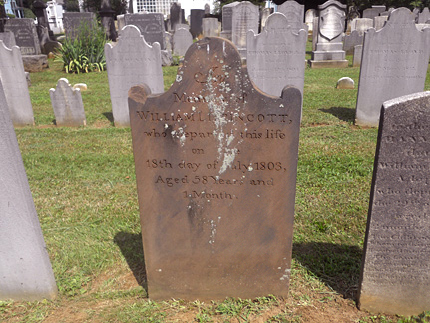
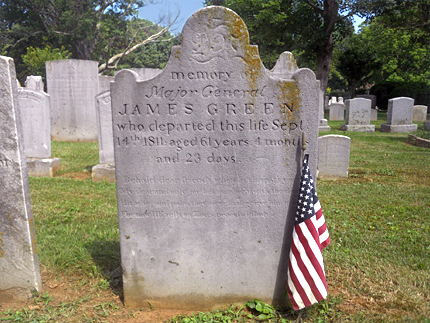
Christ Church and Cemetery
380 Sycamore Ave. and Broad St.
Map / Directions to Christ Church
The Church [9]
Christ Church of Shrewsbury was established in 1702.
The church building which stands here today was constructed between 1769 and 1774.
At some point during the Revolutionary War, Christ Church was occupied by American soldiers who used it as a barracks. The church, which is now Episcopalian, was then Anglican or "Church of England." As such, it was a symbol of the British Crown, and in protest, the American soldiers fired musket shots at the church's pulpit and the orb and crown on the steeple.
A piece of wood with an embedded musket ball and the damaged orb from the steeple are still in the church's possession. These and other historic artifacts are put on display as part of the church's Lantern Tours, which take place every year on the first Friday of December. Among the other items displayed during these tours is a copy of the Book of Common Prayer which was given to the church by William Franklin, who was then serving as the Royal Governor of New Jersey. William was the son of Benjamin Franklin.
The Cemetery
The church's cemetery contains the graves of the thirteen Revolutionary War veterans listed below: [10]
Private Edward Bennett
First Regiment of Monmouth Militia
Private Joseph Dennis
First Regiment of Monmouth Militia
General James Greene,
During the Revolutionary War, Green served as
a captain, Company of Light Horse, Monmouth Militia.
After the Revolutionary War, he
rose to rank of Major General.
Private John Haggerty
First Regiment of Monmouth Militia
Private William Lippincott
First Regiment of Monmouth Militia
Corporal Thomas Lloyd
in First Regiment of Monmouth Militia
Private Lewis McKnight
First Regiment of Monmouth Militia
Private Thomas Morford
First Regiment of Monmouth Militia
Private John Slocum
First Regiment of Monmouth Militia
Private Holmes Throckmorton
Continental Army
Served with General John Sullivan's Division against
the Six Nations in Western, Pa., and New York in 1779
Private James Throckmorton,
Private, Monmouth Grenadiers,
also a minuteman, troop of light horse.
Private Job Throckmorton
First Regiment of Monmouth Militia
Private John West
First Regiment of Monmouth Militia
Another notable grave in the Christ Church cemetery is that of Lyttleton White (1813-1885), whose description of the Allen House Massacre is quoted in the Allen House entry above on this page.

1. ^ Margie Hofer, "A Tavern for the Town: Josiah Halstead's Tavern and Community Life in Eighteenth-Century Shrewsbury" (Freehold, NJ: Monmouth County Historical Association, 1994)
For further information about Josiah Halstead, see:
• Michael Adelberg, The American Revolution in Monmouth County: Notes to Accompany the Book and Additional Essay (For the Monmouth County Historical Association, November 2010) Pages 6-8.
Available to be read here
2. ^ Journals of the Continental Congress, Volume 1 (Washington D.C., U.S. Government Printing Office, 1904) Pages 75 - 80
Available to be read at Google Books here
▸ Thursday, October 20, 1774 entry:
The relevant section of the document is section 11, which appears on page 79 and is quoted in full below:
"That a committee be chosen in every county, city, and town by those who are qualified to vote for representatives in the legislature, whose business it shall be attentively to observe the conduct of all persons touching this association; and when it shall be made to appear, to the satisfaction of a majority of any such committee, that any person within the limits of their appointment has violated this association, that such majority do forthwith cause the truth of the case to be published in the gazette; to the end, that all such foes to the rights of British-America may be publicly known, and universally contemned as the enemies of American liberty; and thenceforth we respectively will break off all dealings with him or her."
3. ^ "Advertisement calling a meeting of the inhabitants of Shrewsbury for the 17th of January, to choose a Committee in accordance with the recommendations of the Continental Congress," reprinted in:
Frederick W. Ricord and William Nelson, Editors, Documents Relating to the Colonial, Revolutionary and Post-Revolutionary History of the State of New Jersey, Volume X (Newark: Daily Advertiser Printing House) Page 533
Available to be read at Google Books here4. ^ Extract from a Letter to a gentleman In New York, Dated Shrewsbury, New-Jersey, January 18, 1775, reprinted in:
Edwin Salter, A History of Monmouth and Ocean Counties (Bayonne: E. Gardner & Son, Publishers, 1890) Pages 54 and 55
Available to be read at the Internet Archive here
5. ^ "Letter from the Freehold Committee of Inspection by Nath. Scudder, Clerk to the 'Respectable Inhabitants of the Township of Shrewsbury at their Annual Town Meeting'," reprinted in:
Frederick W. Ricord and William Nelson, Editors, Documents Relating to the Colonial, Revolutionary and Post-Revolutionary History of the State of New Jersey, Volume X (Newark: Daily Advertiser Printing House) Pages 559-560
Available to be read at Google Books here
6. ^ "Proceedings of the Inhabitants of Shrewsbury," reprinted in:
Frederick W. Ricord and William Nelson, Editors, Documents Relating to the Colonial, Revolutionary and Post-Revolutionary History of the State of New Jersey, Volume X (Newark: Daily Advertiser Printing House) Pages 600-601
Available to be read at Google Books here~ Margie Hofer, "A Tavern for the Town: Josiah Halstead's Tavern and Community Life in Eighteenth-Century Shrewsbury" (Monmouth County Historical Assoc.: Freehold, NJ, 1994)
On page 13, Hofer states that the May 27, 1775 meeting was held "at the tavern of Jeremiah Bonham in Eatontown."7. ^ Margie Hofer, "A Tavern for the Town: Josiah Halstead's Tavern and Community Life in Eighteenth-Century Shrewsbury" (Freehold, NJ: Monmouth County Historical Association, 1994) Page 14
8. ^ Lyttleton White letter to Reverend Daniel V. McLean, Shrewsbury, March 25, 1846
Transcribed from a copy of White's handwritten letter, obtained at the Monmouth County Historical AssociationWhite's letter is the only known documentation of the Allen House Massacre. In the letter, Lyttleton White claimed that he heard the story "from the lips of the above Joseph Price - after he had Returned Back here from Nova Scotia, perhaps 6 or 7 more times." White also claimed to have been the carpenter who laid down a new wood floor in the house in 1812 because of the blood stains on the floor which dated back to the massacre.
Despite this being the only documentation of the "Allen House Massacre" and that it was written sixty-seven years after the event by White who had heard the story second hand, there are good reasons for accepting the story as essentially correct. Historian Michael S. Adelberg made a convincing case for accepting White's story in his 1995 article, The Allen House Massacre: Establishing the Credibility of a Letter to Determine a Historical Fact. (Available at the Monmouth County Historical Association).
I agree with Adelberg that even though White's letter is the only documentation of the Allen House Massacre and was written decades after the event, the story is most likely true, although White's letter might have gotten some details wrong or exaggerated them.
9. ^ Information about the history of the church was drawn from the History page of the Christ Church of Shrewsbury Website, and from an email correspondence with Christ Church historian Robert M. Kelly, Jr., on August 24, 2016.
10. ^ Information provided by Christ Church historian Robert M. Kelly, Jr., in an email correspondence on August 24, 2016.
I would like to thank the following people who took the time to provide me with information or documents which went into the research for this page:
• Michael S. Adelberg
• Christ Church Historian Robert M. Kelly, Jr.
• Debbie Carmody of the Monmouth County Historical Association